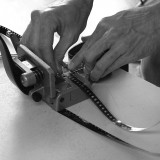The Art of Decision-Making
by Joshua Rothman, newyorker.com
Your life choices are shadowed by ignorance: you choose to be a parent without knowing what being a parent will be like.
” The craft of making farsighted choices—decisions that require long periods of deliberation, decisions whose consequences might last for years,” he concludes, “is a strangely under-appreciated skill.”
We say that we “decide” to get married, to have children, to live in particular cities or embark on particular careers, and in a sense this is true. But how do we actually make those choices?
One of the paradoxes of life is that our big decisions are often less calculated than our small ones are. We agonize over what to stream on Netflix, then let TV shows persuade us to move to New York; buying a new laptop may involve weeks of Internet research, but the deliberations behind a life-changing breakup could consist of a few bottles of wine.
We’re hardly more advanced than the ancient Persians, who, Herodotus says, made big decisions by discussing them twice: once while drunk, once while sober.

…the people in charge drew upon insights from “decision science,” a research field at the intersection of behavioral economics, psychology, and management. He thinks that we should apply such techniques to our own lives.
In “War and Peace,” Tolstoy writes that, while an armchair general may imagine himself “analyzing some campaign on a map” and then issuing orders, a real general never finds himself at “the beginning of some event”; instead, he is perpetually situated in the middle of a series of events, each a link in an endless chain of causation.
For Tolstoy, the tendency of big decisions to make themselves was one of the great mysteries of existence. It suggested that the stories we tell about our lives are inadequate to their real complexity.
He wants to make us writers, rather than readers, of our own stories. Doing so requires engaging with one of life’s fundamental questions: Are we in charge of the ways we change?

In reality, we make decisions in imperfect conditions that prevent us from thinking things through. This, Johnson explains, is the problem of “bounded rationality.”
Choices are constrained by earlier choices; facts go undiscovered, ignored, or misunderstood; decision-makers are compromised by groupthink and by their own fallible minds.
The most complex decisions harbor “conflicting objectives” and “undiscovered options,” requiring us to predict future possibilities that can be grasped, confusingly, only at “varied levels of uncertainty.”
Life’s truly consequential choices, Johnson says, “can’t be understood on a single scale.”
Suppose you’re offered two jobs: one at Partners in Health, which brings medical care to the world’s neediest people, and the other at Goldman Sachs. You must consider which option would be most appealing today, later this year, and decades from now; which would be preferable emotionally, financially, and morally; and which is better for you, your family, and society.
From this multidimensional matrix, a decision must emerge.
Many of the best processes unfold in stages—a divergence stage might precede a convergence stage—and are undertaken by groups.
In a series of meetings known as a “design charrette”—the concept is borrowed from the field of product design—a large problem is divided into subproblems, each of which is assigned to a group; the groups then present their work to the whole team, receive feedback, regroup, and revise, in a cycle that loops until a decision has been made.
Charrettes are useful not just because they break up the work but because they force groups with different priorities and sensibilities—coders and designers, architects and real-estate developers—to interact, broadening the range of available viewpoints.
At firms like Royal Dutch Shell, where growth requires investing in expensive ventures, such as ports, wells, and pipelines, deciders use “scenario planning” to imagine how such investments might play out.
(A scenario-planning starter kit, Johnson writes, contains three possible futures: “You build one model where things get better, one where they get worse, and one where they get weird.”)
Military planners use immersive war games, carried out in the field or around a table, to bring more of the “decision map” into view. In such games, our enemies discover possibilities that we can’t foresee, ameliorating the poverty of our individual imaginations. And since the games can be played over and over, they allow decision-makers to “rewind the tape,” exploring many branches of the “decision tree.”
“Decision theory,” the destination on which they’ve converged, has tended to hold that sound decisions flow from values.
Faced with a choice—should we major in economics or in art history?—we first ask ourselves what we value, then seek to maximize that value.
From this perspective, a decision is essentially a value-maximizing equation

In recent decades, some philosophers have grown dissatisfied with decision theory. They point out that it becomes less useful when we’re unsure what we care about, or when we anticipate that what we care about might shift.
The point of such a move isn’t to maximize one’s values. It’s to reconfigure them, rewriting the equations by which one is currently living one’s life.
She tells the story of a man who “hesitated to have children because he did not want to become the ‘boring type’ ” that parents tend to become. “Finally, he did decide to have a child and, with time, he did adopt the boring characteristics of his parent friends—but he was happy!” Whose values were maximized—Old Person’s or New Person’s? Because no value-maximizing formula could capture such a choice, Ullmann-Margalit suggested that, rather than describing this man as having “decided” to have children, we say that he “opted” to have them—“opting” (in her usage) being what we do when we shift our values instead of maximizing them.
The nature of “opting situations,” she thought, explains why people “are in fact more casual and cavalier in the way they handle their big decisions than in the way they handle their ordinary decisions.” Yet it’s our unexplored options that haunt us.
“Perhaps you think that you can know what it’s like to have a child, even though you’ve never had one, because you can read or listen to the testimony of what it was like for others. You are wrong.”
These activities may sound like torture to the childless version of yourself, but the parental version may find them illuminated by love, and so redeemed. You may end up becoming a different person—a parent. The problem is that you can’t really know, in advance, what “being a parent” is like.
Part of being alive is awaiting the “revelation” of “who you’ll become.”
…she writes that “becoming a parent is neither something that just happens to you nor something you decide to have happen to you.” Instead, Callard maintains, we “aspire” to self-transformation by trying on the values that we hope one day to possess, just as we might strike a pose in the mirror before heading out on a date.
In place of a moment of decision, Callard sees a more gradual process: “Old Person aspires to become New Person.”

(“Turning ambition into aspiration is one of the job descriptions of any teacher,” Callard notes.) The ambitious students find it easy to explain why they’re taking the class. But the aspirants must grow comfortable with a certain quantity of awkward pretense.
The truth, which is harder to communicate, is that you have some vague sense of its value, which you hope that some future version of yourself might properly grasp.
Until aspirants can fully explain their motivations, they often understate their aims.
Being a well-meaning phony is key to our self-transformations.
These are “bad” reasons for listening to classical music, Callard says, but “ ‘bad’ reasons are how she moves herself forward, all the while seeing them as bad, which is to say, as placeholders for the ‘real’ reason.”
“Everyone goes to college ‘to become educated,’ ” Callard observes, “but until I am educated I do not really know what an education is or why it is important.”
If we couldn’t aspire to changes that we struggle to describe, we’d be trapped within the ideas that we already have.
Our inability to explain our reasons is a measure of how far we wish to travel. It’s only after an aspirant has reached her destination, Callard writes, that “she will say, ‘This was why.’ ”
Because aspirations take a long time to come to fruition, they’re always at risk of interruption.
To aspire, Callard writes, is to judge one’s present-day self by the standards of a future self who doesn’t yet exist. But that can leave us like a spider plant putting down roots in the air, hoping for soil that may never arrive.
She sees infertility as a form of interrupted aspiration. An aspiring mother who can’t have children is rational in feeling sad, she writes, and “this is so even if—indeed, it is true in part because—she cannot quite see what she would be missing.”
For much of that time, we lived with what Callard describes as the “distinctive kind of sadness appropriate to losing something you were only starting to try to get to know.”












